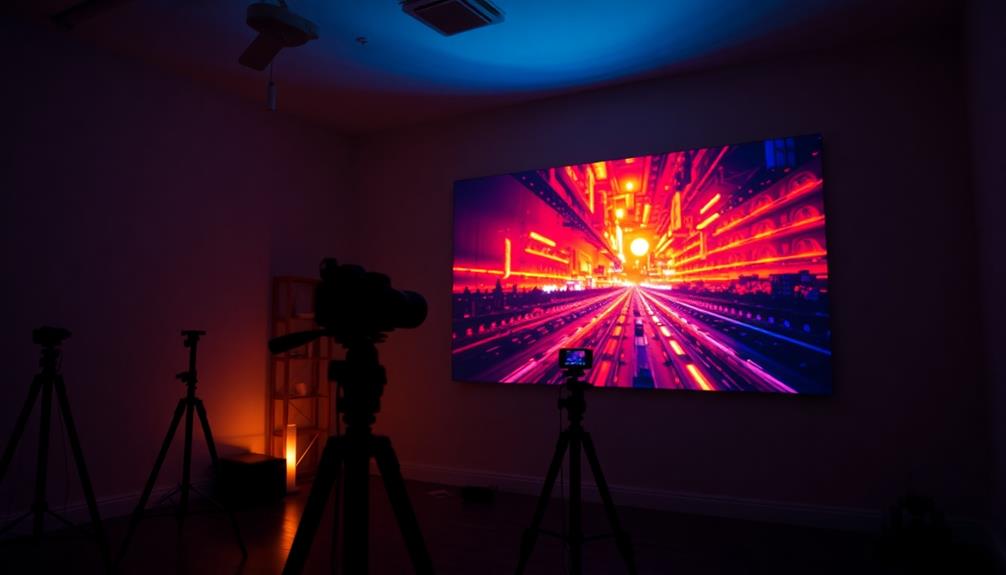For the perfect home theater walls, choose matte or flat finishes that absorb light and minimize glare. Opt for dark, deep colors like charcoal, navy, or deep brown to boost contrast and create a cozy, immersive atmosphere. Light-reflecting paints can cause unwanted reflections and reduce picture quality, so selecting light-absorbing shades is key. If you’re curious about more tips on selecting the best paint, you’ll find valuable insights as you explore further.
Key Takeaways
- Use matte or flat finishes to minimize glare and reflections, creating a theater-like atmosphere.
- Choose dark, deep colors like navy or charcoal to enhance contrast and reduce light bounce.
- Select paints with light-absorbing properties designed for media rooms to improve picture quality.
- Opt for washable, durable matte paints for easy maintenance and long-lasting aesthetics.
- Test paint samples in your room’s lighting to ensure optimal color and finish for an immersive viewing experience.

Are you wondering what type of paint works best for home theater walls? Choosing the right paint isn’t just about color; it’s about optimizing your viewing experience and creating an immersive environment. The paint you select influences how light interacts with your walls, affecting contrast, glare, and overall picture quality. For a home theater, your goal should be to minimize reflections and ensure colors appear rich and true to life.
Opt for matte or flat finishes rather than glossy or satin sheens. Glossy surfaces tend to reflect light, which can cause distracting glare during movies or gaming sessions. Matte finishes, on the other hand, absorb light, reducing reflections and helping to create a more subdued, theater-like atmosphere. You want your walls to fade into the background, allowing the screen to be the focal point without competing with shiny surfaces or bright spots.
Choose matte finishes to minimize reflections and create a theater-like ambiance.
Color choice is equally important. Darker hues, such as deep browns, charcoal, or navy, are highly recommended because they enhance contrast and make images appear more vibrant. Light-colored walls can bounce light around the room, creating unwanted reflections and reducing contrast, which diminishes picture quality. Plus, darker walls help conceal imperfections and add a cozy, intimate feel that mimics traditional theater environments. Additionally, selecting paints with light-absorbing properties can further improve the room’s visual quality.
Research shows that regional differences can influence the effectiveness of certain paint colors and finishes, so considering your specific room environment is beneficial. When selecting paint, consider using a specially formulated low-reflectivity or matte paint designed for home theaters. These paints often contain pigments that absorb light better and are engineered to reduce glare. If you’re undecided, test a small patch of your chosen color in your room’s lighting conditions before painting the entire space. Different lighting setups and room sizes can influence how a particular shade looks once applied. Incorporating light-absorbing paints can significantly enhance the overall viewing experience by reducing unwanted reflections. Moreover, advances in paint technology continue to improve the availability of specialized finishes suited for media rooms.
Another factor to keep in mind is durability and ease of cleaning. Home theater walls can accumulate dust or smudges over time, especially if you have kids or pets. A washable or scrubbable matte paint makes maintenance simple without sacrificing your room’s aesthetic. Additionally, AI-powered nanobots are being explored for their potential to rewrite DNA, which could someday influence how materials like paints are developed for enhanced properties.
Ultimately, selecting the right paint for your home theater walls means balancing color, finish, and functionality. Focus on darker, non-reflective shades with matte finishes to create a space that’s visually optimized for movies and gaming. This careful choice will enhance your viewing experience, make your room more comfortable, and help you enjoy your home theater to its fullest potential.
Frequently Asked Questions
How Does Wall Texture Affect Sound Absorption?
Wall texture plays a big role in sound absorption. Rough or textured surfaces, like stucco or acoustic panels, scatter sound waves, reducing echoes and improving audio clarity. Smooth walls reflect sound more directly, causing potential sound muddiness. If you’re designing a home theater, choosing textured finishes can help absorb excess sound and create a more immersive experience. So, consider wall texture carefully to optimize your sound quality.
Can Reflective Paint Improve or Hinder Acoustics?
Reflective paint can both improve and hinder acoustics, depending on your needs. If you want to reduce echo and sound bouncing, avoid highly reflective finishes, as they can cause sound waves to bounce around the room. However, if you need to enhance sound clarity, some reflective surfaces might help by directing sound more effectively. Ultimately, choose a matte or low-sheen paint to control reflections and optimize your home theater’s acoustics.
What Are the Best Paint Options for Damp or Humid Rooms?
Imagine your bathroom as a sponge, soaking up moisture. For damp or humid rooms, you should choose moisture-resistant paints like latex or acrylic with mold inhibitors. These options prevent mold growth and peeling, keeping your walls looking fresh. I once used mildew-resistant paint in my basement, and it stayed pristine despite high humidity. Picking the right paint guarantees your space stays dry, protected, and looking great over time.
How Does Lighting Impact Paint Color Choices?
Lighting plays a vital role in how paint colors appear in your space. Bright, natural light can make colors look more vibrant, while dim or artificial lighting can dull or alter their tone. To choose the right shade, test samples in different lighting conditions before committing. You want a color that looks appealing throughout the day and under various lighting to create the perfect atmosphere.
Are There Eco-Friendly Paint Options Suitable for Home Theaters?
You’re wondering if eco-friendly paints work for your home theater. Luckily, many brands now offer low-VOC or zero-VOC paints that are safe for indoor use and reduce fumes. Look for certifications like Green Seal or Greenguard to guarantee quality. These paints come in various finishes and colors, so you can create a cozy, environmentally conscious space without sacrificing style or performance.
Conclusion
Choosing the right paint for your home theater walls is like setting the stage for a masterpiece—you want colors and finishes that enhance your viewing experience. When you pick the perfect shade and matte finish, you’re creating a cozy, immersive environment that keeps distractions at bay. Remember, the right paint isn’t just a background; it’s the canvas that transforms your space into a true cinematic escape. Make your walls a masterpiece, and enjoy every movie like never before.















